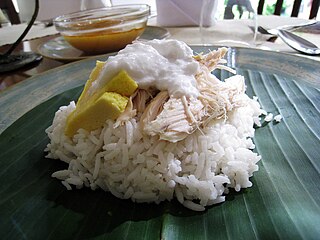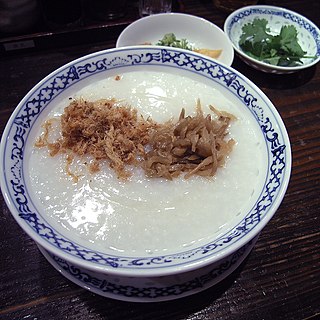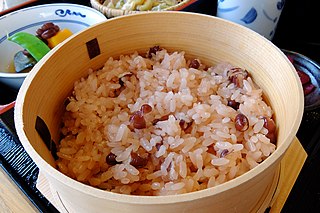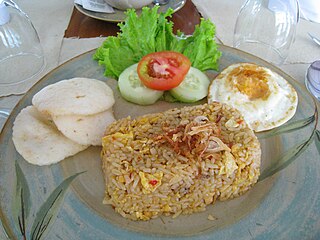
Jambalaya is an American Creole and Cajun rice dish of French, African, and Spanish influence, consisting mainly of meat and vegetables mixed with rice.

Pilaf or pilau a rice dish, or in some regions, a wheat dish, whose recipe usually involves cooking in stock or broth, adding spices, and other ingredients such as vegetables or meat, and employing some technique for achieving cooked grains that do not adhere to each other.

Mexican rice, also known as arroz a la mexicana, arroz mexicano, or arroz rojo in Spanish, is a Mexican side dish made from white rice, tomato, garlic, onion, and perhaps other ingredients. Mexican rice is almost always eaten as a complement to other dishes such as mole, refried beans, rotisserie chicken, carne asada, picadillo, tacos, fried fish, fried chicken, chiles rellenos, or vegetable soup.

Red beans and rice is an emblematic dish of Louisiana Creole cuisine traditionally made on Mondays with Kidney beans, vegetables, spices and pork bones as left over from Sunday dinner, cooked together slowly in a pot and served over rice. Meats such as ham, sausage, and tasso ham are also frequently used in the dish. The dish is customary – ham was traditionally a Sunday meal and Monday was washday. A pot of beans could sit on the stove and simmer while the women were busy scrubbing clothes. The dish is now fairly common throughout the Southeast. Similar dishes are common in Latin American cuisine, including moros y cristianos, gallo pinto and feijoada.

Char siu is a Cantonese–style of barbecued pork. Originating in Guangdong, it is eaten with rice, used as an ingredient for noodle dishes or in stir fries, and as a filling for chasiu baau or pineapple buns. Five-spice powder is the primary spice, honey or other sweeteners are used as a glaze, and the characteristic red color comes from the red yeast rice when made traditionally.

Rice and beans, or beans and rice, is a category of dishes from many cultures around the world, whereby the staple foods of rice and beans are combined in some manner. The grain and legume combination provides several important nutrients and many calories, and both foods are widely available. The beans are usually seasoned, while the rice may be plain or seasoned. The two components may be mixed together, separated on the plate, or served separately.

Dirty rice is a traditional Louisiana Creole dish made from white rice which gets a "dirty" color from being cooked with small pieces of pork, beef or chicken, green bell pepper, celery, and onion, and spiced with cayenne and black pepper. Parsley and chopped green onions are common garnishes. Dirty rice is most common in the Creole regions of southern Louisiana; however, it can also be found in other areas of the American South and referenced as "chicken and rice," "Cajun rice," or "rice dressing".

Hoppin' John, also known as Carolina peas and rice, is a peas and rice dish served in the Southern United States. It is made with cowpeas and rice, chopped onion, and sliced bacon, seasoned with salt. Some recipes use ham hock, fatback, country sausage, or smoked turkey parts instead of bacon. A few use green peppers or vinegar and spices. Smaller than black-eyed peas, field peas are used in the South Carolina Lowcountry and coastal Georgia; black-eyed peas are the norm elsewhere.

Green curry is a central Thai variety of curry.

Ghanaian cuisines refer to the meals of the Ghanaian people. The main dishes of Ghana are organized around starchy staple foods, which goes with either sauce or soup accompanied with a source of protein. The main ingredients for the vast majority of soups and stews are; tomatoes, hot peppers and onions. Most Ghanaian soups and stews are red or orange in appearance as a result of the main ingredients used.

Afghan cuisine is influenced to a certain extent by Persian, Central Asian and Indian cuisines due to Afghanistan's close proximity and cultural ties. The cuisine is halal and mainly based on mutton, beef, poultry and fish with rice and Afghan bread. Accompanying these are common vegetables and dairy products, such as milk, yogurt, whey, etc., and fresh and dried fruits such as apples, apricots, grapes, bananas, oranges, plums, pomegranates, sweet melons, raisins, etc. The diet of most Afghans revolve around rice-based dishes, while various forms of naan is consumed with most meals. Tea is generally consumed daily in large quantities, and is a major part of hospitality. The culinary specialties reflect the nation's ethnic and geographic diversity. The national dish of Afghanistan is Qabili Palau, a rice dish cooked with raisins, carrots, nuts and lamb or beef.

Theeyal is a South Indian dish originating from the Indian state of Kerala. It has a soupy consistency, and is made from a mixture of spices consisting of roasted coconut, coriander seeds, dried red chili and fenugreek. All spices are ground to a paste and cooked in tamarind water with vegetables. When completed it looks like a rich medium brown gravy and is normally served with rice.

Chitranna is a rice-based dish widely prepared in South India. It is prepared by mixing cooked rice with a special seasoning called Oggarane or Gojju. Characteristic for the seasoning are mustard seeds, fried lentils, peanuts, curry leaves, chillies, lemon juice and other optional items such as scrapes of unripe mango. Added Turmeric powder gives Chitranna its yellow color. Garlic and onions are also used in the seasoning by some, although traditionally they do not form part of the recipe. The dish is especially popular in the south Indian state of Karnataka, where it has become a part of the daily diet.

Coconut rice is a dish prepared by cooking white rice in coconut milk or coconut flakes. As both the coconut and the rice-plant are commonly found in the tropics all-around the world, coconut rice too is found in many cultures throughout the world, spanning across the equator from the Indian subcontinent, Southeast Asia, South America, Central America, West Africa, East Africa, the Caribbean and Oceania.

Patjuk is a type of Korean juk consisting of red beans and rice. It is commonly eaten during the winter season in Korea, and is associated to dongji, as people used to believe that the red color of patjuk drives off baneful spirits.

Mont di is a collective term for Burmese dishes made with thin rice noodles. The vermicelli is used fresh, as it ferments quickly in Myanmar's tropical climate. There are a number of mont di dishes, and the Rakhine mont di of the Arakanese from western Myanmar is the most popular. Mandalay mont di is another well-known dish. A handful of regional rice vermicelli dishes, such as Mawlamyaing mohinga and Kengtung khao sen, are also interchangeably called "mont di."

Congee or conjee is a type of mostly savoury rice porridge or gruel of Asian origin. It can be eaten plain, where it is typically served with side dishes, or it can be served with ingredients such as meat, fish, seasonings and flavourings, most often savory, but sometimes sweet. It is typically served as a meal on its own, especially for breakfast or people who are ill. Names for congee are as varied as the style of its preparation, but all are made with rice cooked as a softened porridge with a larger quantity of water than other types of cooked rice like pilaf or claypot rice.

A stew is a combination of solid food ingredients that have been cooked in liquid and served in the resultant gravy. Ingredients can include any combination of vegetables and may include meat, especially tougher meats suitable for slow-cooking, such as beef, pork, venison, rabbit, lamb, poultry, sausages, and seafood. While water can be used as the stew-cooking liquid, stock is also common. A small amount of red wine or other alcohol is sometimes added for flavour. Seasonings and flavourings may also be added. Stews are typically cooked at a relatively low temperature, allowing flavours to mingle.

Red bean rice, called patbap (팥밥) in Korean, sekihan (赤飯) in Japanese, and hóngdòu fàn (红豆饭) in Chinese, is an East Asian rice dish consisting of rice cooked with red beans.

Nasi goreng jawa is a Javanese-style of fried rice originated from Java, Indonesia. This dish can be found in Javanese cuisine and quite popular in Indonesia, especially Java. Commonly, this rice dish uses sambal ulek as seasoning and has a spicy taste.



















